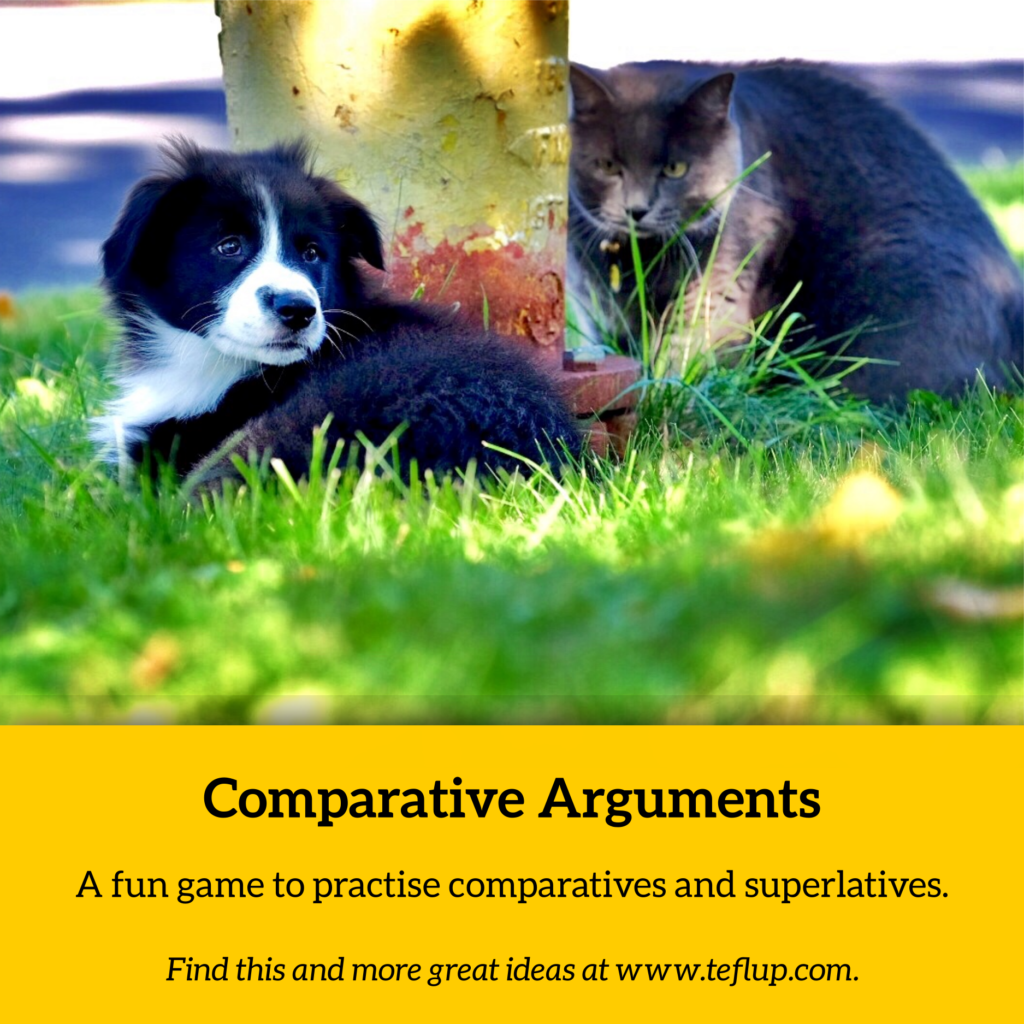For more ESL games and activities, click here.
Comparative Arguments
One way we authentically use comparative and superlative adjectives is to argue about which things are better or the best. Although this exercise doesn’t encourage students to directly argue for one or another thing being better, it does practise this language in the guise of a game.
- Focus: Grammar, Speaking
- Level: Any
- Age: Teens/Adult
- Target Language: Adjectives
- Time: 10 minutes+
- Preparation: Minimal

Procedure:
1: Divide the class into between two and five teams. Three is optimum in providing enough competition between students and ensuring the game moves at a swift enough pace.
2: Either tell, or show and elicit, the first objects for comparison (e.g. cats and dogs). Give students time to brainstorm the differences between these two objects. Clarify that students do not need to prepare arguments for why one is better, they simply need to come up with adjectives that they can use to compare these two things.
3: Start with one team and ask them to give a sentence making a comparison between the objects for comparison. Each sentence must contain a different adjective (or adverb). The last team who can keep providing new sentences wins a point.
You need to decide whether it is fine for a team to invert the previous teams sentence and use the opposite adjective (including switching more for less) e.g. Dogs are more loyal than cats/Cats are less loyal than dogs. If you have an odd number of teams (as opposed to a number of odd teams!), then this will not cause as much of a problem as it will for an even number of teams. You may also want to decide how you will deal with sentences which are grammatically correct, but seem factually inaccurate e.g. cats are larger than dogs.
4: Show or tell the students the next objects for comparison. Give some time to brainstorm and then repeat stage 3.
5: The team with the most points at the end of the game are the winner.
Example:
T1: Cats are cuter than dogs.
T2: Dogs are more dangerous than cats.
T3: Cats are smaller than dogs.
T1: Dogs are bigger than cats.
Variations:
1. Use three objects for comparison to include the use of the superlative. These can be very creative if the objects are completely different (e.g. a pencil, a chainsaw and a piece of cheese).
2. You could also allow similarities. This would entail phrases such as “as … as” and “they are both …”
Follow on:
One potential activity that would naturally follow on from a comparative argument is to have an actual debate on something. You could repurpose the comparison topics below, this time with each team arguing for one side. In some cases, more context would be necessary. For example, if you want students to argue about the differences between two countries, it may be necessary to establish whether it is in relation to travelling there on holiday, as a place to study or some other context.
Example Comparisons:
Cats v dogs
iPhone v Samsung Galaxy
House v flat
The UK v students’ country
English v students’ L1
Books v films
Science v art
Boys v girls
Pencil v hammer v coin
A boxer v a firefighter v a teacher
Captain Jack Sparrow v Spongebob Squarepants v Voldemort
Spiderman v Batman v Ironman
Rock v paper v scissors
Russia v South Africa v Brazil
Elephant v mouse v cheetah
Earth v the moon v the sun




